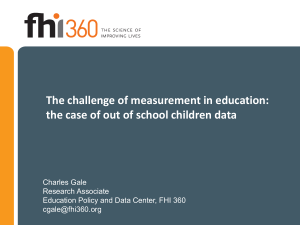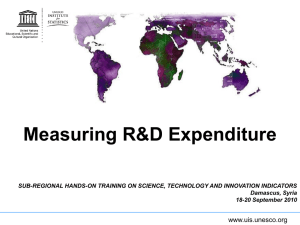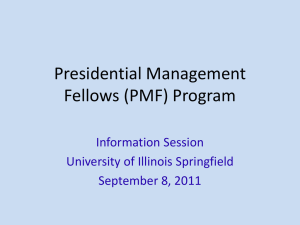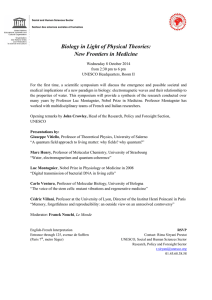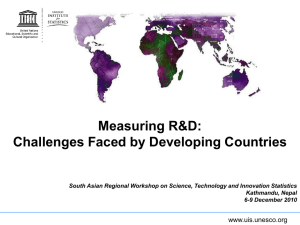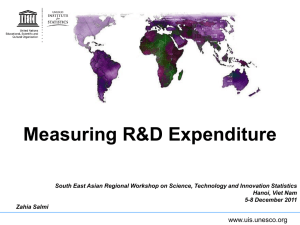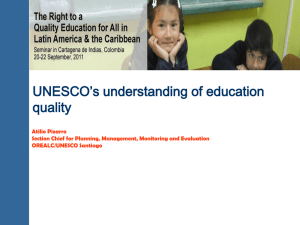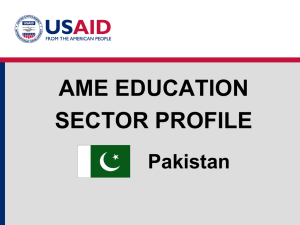Measuring Research and Experimental Development
advertisement
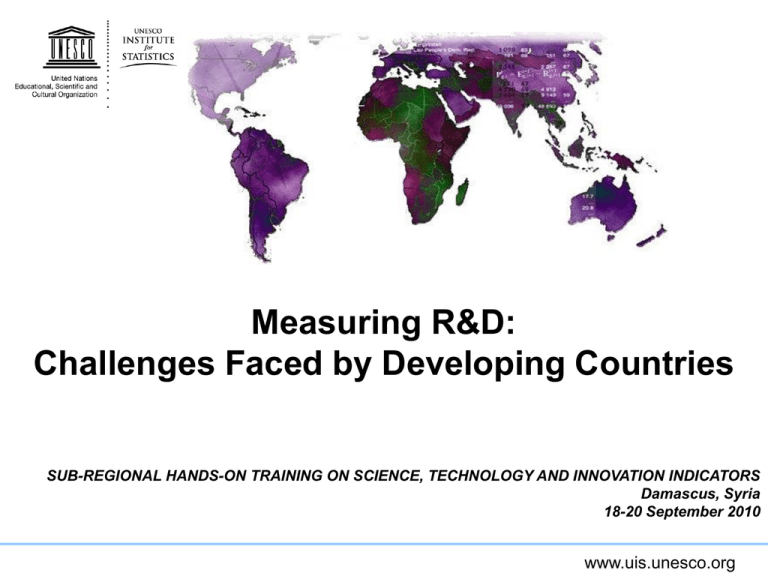
Measuring R&D: Challenges Faced by Developing Countries SUB-REGIONAL HANDS-ON TRAINING ON SCIENCE, TECHNOLOGY AND INNOVATION INDICATORS Damascus, Syria 18-20 September 2010 www.uis.unesco.org Products www.uis.unesco.org Outline The problem The process Contents of the Technical Guide Thinking ahead www.uis.unesco.org R&D statistics in developing countries (1) Recognition, meeting targets, evidence-based S&T policy, but: • lack of interest at the level of policy makers (low policyrelevance?) • S&T is still not properly represented in economic/social public policies. lack of resources devoted to statistics in S&T • lack of technical knowledge for the production of crossnationally comparable R&D statistics • weak statistical institutions • difficulties in applying FM concepts and methods www.uis.unesco.org R&D statistics in developing countries (2) Particular characteristics of R&D activities to be taken into account: • R&D performers function within the specific context of a national, cultural, political, financial and economic system • different structures in terms of government, innovation system, higher education system, statistical system • particular ‘culture of information’ • Users of R&D stat: Gov, analysts. + international donor agencies S&T indicators • adapted to particular policy needs • provide answers to actual policy questions However, international comparability is foremost www.uis.unesco.org The process (1) Experience acquired through the UIS work, in particular through direct contact with S&T statisticians in numerous workshops and other meetings around the developing world. Advisory Meeting to the UIS S&T Statistics Programme held in Montreal, Canada, December 2007. Papers commissioned by UIS to Jacques Gaillard (IRD, Paris), Michael Kahn et al (HSRC, South Africa), and Gustavo Arber et al (RICYT, Argentina). Proposal for an annex to the Frascati Manual on measuring R&D in developing countries was presented at the OECD 2008 and 2009 NESTI meeting. www.uis.unesco.org The process (2) Expert Meeting on Measuring R&D in Developing Countries in Windhoek, Namibia, 14 to 16 September 2009 Consultant has drafted: • Technical Guide on Measuring R&D: Challenges for Developing Countries • Proposed Annex to the Frascati Manual Both to be released in 2010 Some of the issues might also present measurement challenges for a future revision of the Frascati Manual www.uis.unesco.org Contents of the Technical Guide 1. Introduction 2. The nature of R&D activity in developing countries 3. R&D expenditure 4. Internal and international mobility of the R&D workforce 5. Specific fields of R&D activity 6. Foreign and internationally controlled entities 7. Strengthening R&D statistical systems 8. Thinking ahead www.uis.unesco.org Chapter 2: The nature of R&D activity in developing countries The growing importance of R&D • More ‘R’ than ‘D’ in developing countries. • Strong presence of the government and higher education sectors in the performance of R&D. Lower emphasis on R&D in business sector. • Occasional R&D / Informal R&D • Special types of R&D www.uis.unesco.org Chapter 2: The nature of R&D activity in developing countries cont… Heterogeneity and concentration • Developing countries are a heterogeneous group: » Group A: countries with consolidated R&D systems and developed S&T statistics systems no major difficulties in applying Frascati Manual concepts. » Group B: countries with consolidated R&D systems and less developed S&T statistics systems need specific guidance on how to establish and consolidate sound R&D statistics systems. » Group C: countries with incipient R&D systems need specific guidelines on how to start creating a regular R&D statistical collection. • High degree of concentration (in group of countries, in particular institutions, in major projects, etc) lead to volatility and inconsistencies in statistics. www.uis.unesco.org Chapter 3: R&D expenditure Use of secondary data from national budget New sources of funds emerging Discrepancy between voted and allocated budget Budgetary commitments are not followed up Mixing of budgetary records and annual reports from performing units Definition of S&T / R&D budgets Identifying R&D components in the national budget State-owned enterprises, university-owned companies and national scientific academies Private universities Fiscal year vs. calendar year Information systems in government and higher education inadequate for statistics www.uis.unesco.org Chapter 4: Internal and international mobility of the R&D workforce Underestimation of researchers Unpaid research Informal research Research outside of the normal work setting with external funding Multiple part time positions not taken into account or undercounted Master’s research www.uis.unesco.org Counting researchers Overestimation of researchers Counting the contract instead of the real effort Multiple full-time research positions www.uis.unesco.org Counting researchers Special cases FTE calculation >1 and FTE>HC R&D in times of crisis Visiting researchers Brain circulation www.uis.unesco.org Counting researchers Recommendations Peer interviews of researchers Include a module on barriers Use secondary sources • Publication databases, both national and international • STMIS and other databases of researchers • Databases and registers of clinical trials • Databases and registers of the main foreign donors involved in funding R&D in the countries • University accreditation databases www.uis.unesco.org Chapter 5: Specific fields of R&D activity Traditional knowledge Clinical trials Industrial activities Other activities www.uis.unesco.org Special types of R&D - Traditional knowledge Traditional knowledge (TK) A cumulative body of knowledge, know-how, practices and representations maintained and developed by peoples with extended histories of interaction with the natural environment. These sophisticated sets of understandings, interpretations and meanings are part and parcel of a cultural complex that encompasses language, naming and classification systems, resource use practices, ritual, spirituality and worldview. www.uis.unesco.org Special types of R&D - Traditional knowledge Dichotomy between traditional and scientific knowledge systems substantive grounds – because of differences in the subject matter and characteristics of traditional and scientific knowledge methodological and epistemological grounds – because the two forms of knowledge employ different methods to investigate reality contextual grounds – because traditional knowledge is more deeply rooted in its environment www.uis.unesco.org Special types of R&D - Traditional knowledge Links between traditional and scientific knowledge systems Scientific approach to TK (in ethno-botany, ethnopedology, ethno-forestry, ethno-veterinary medicine, ethnoecology, etc). The application of scientific methods to TK, converting it into a source of scientific information. (in biodiversity science or nature conservation; traditional health and pharmacopeia). Interaction between scientists and communities in participatory technology development www.uis.unesco.org Special types of R&D - Traditional knowledge Measurement issues and recommendations Establish the boundaries for TK (what qualify as R&D) The activities establishing an interface between traditional knowledge and R&D Some fields of activities in TK are transdisciplinary (e.g. ethno-botany), making them extremely difficult to map into the current classification’s structure. www.uis.unesco.org Special types of R&D - Clinical trials Clinical trials (Can) involve a significant amount of R&D Need to be conducted on a wide population Growth area for developing countries www.uis.unesco.org Special types of R&D - Clinical trials Measurement of clinical trials Registers of clinical trials available, e.g. WHO but also national Funding often from abroad Performance various possibilities • a local branch of the foreign main sponsor • universities and university hospitals • individual researchers • local medical clinics • locally registered PNPs • international PNPs www.uis.unesco.org Special types of R&D - Clinical trials Measurement issues and recommendations Occupation category of local staff • Medical doctors and other professionals with at least ISCED 5A degrees should be considered as researchers • Nurses and other staff with qualifications below ISCED 5A should be accounted for as technicians FTE calculation is important (often part-time) Attribution of sector of performance must be done with care to avoid double counting www.uis.unesco.org Special types of R&D - Industrial activities Reverse engineering: understanding the structure and functioning of an object (in order to make a new device or program creates a similar object in a different way), copying it, or improving it. Recommendation: If reverse engineering is carried out in the framework of an R&D project to develop a new (and different) product, it should be considered as R&D. www.uis.unesco.org Special types of R&D - Other activities Community development and other social projects • R&D only in development and testing phase experimental development (most probably in the field of social sciences) Religious research • part of humanities, • should be included in R&D surveys. This (religious research) will not be a recommendation www.uis.unesco.org Chapter 6: Foreign and internationally controlled entities Foreign antennas Foreign company’s R&D labs International organizations operating in the country Foreign universities based and conducting R&D in campuses set up in the country www.uis.unesco.org The foreign institutions sector Recommendation Create a “foreign institutions” (FI) sector as a separate sector of performance Funding flowing from this sector to other sectors should be considered from “Abroad” as stated in the main body of the Frascati Manual What is included? • Foreign antennas • International organizations • Foreign company’s R&D labs (remains in the business sector) • Foreign universities (remains in the HE sector) www.uis.unesco.org The foreign institutions sector The principal sector sub-classification Business enterprises Government Higher Education Private non-profit International organizations www.uis.unesco.org Chapter 7: Strategies for setting up S&T statistics systems in developing countries Institutionalizing S&T statistics Establishing registers Structural issues in the private sector and the private not-for-profit sector User-producer networks Science & Technology Management Information Systems and other secondary sources Survey procedures and estimation www.uis.unesco.org Institutionalization of S&T statistics Political support Infrastructure and sustained staff training/capacity building Involvement of NSOs: “Official statistics” status for R&D surveys. Adequate legal framework www.uis.unesco.org Establishing registers R&D in developing countries tends to be very much the purview of public bodies Recommendations: Establishing a database of public sector R&D projects • include human and financial resources; align with national policies. • design could reflect the R&D statistical reporting/definitions. • source for evaluation of such projects. Establishing STMIS • provide overview of research system. • framework for establishing complete registers as sample frames for R&D surveys. www.uis.unesco.org Establishing registers Other sources • associations (trade, academic). • learned societies. • registers or databases of scientists and engineers. • database of research grants. • databases of scientific publications. • patents and other IP documents. • business registers. www.uis.unesco.org Structural issues in the private sector and the PNP sector Publicly-owned businesses play a major role in R&D in some developing countries Recommendations: • should consider issuing data for ‘publicly-owned businesses’ separately from the ‘fully private enterprise sector’. • private enterprises could also be disaggregated by ownership, in particular the various degrees of foreign ownership. www.uis.unesco.org Structural issues in the private sector and the PNP sector Business enterprise R&D is presumed to be generally weak in developing countries when compared to industrial countries. Recommendations: • take into account when conducting sample surveys, perhaps by over-sampling, especially amongst larger companies. • big companies should not be missed out as it might imply significant error. • invest time in interviewing key firms to understand their R&D function and obtain a clear picture of their activity. Private-non-profit sector: make a significant contribution to R&D in developing countries, but the sector tends to be very volatile. www.uis.unesco.org User-producer networks Recommendations: • user-producer networks and other forms of stakeholder consultation should be instituted. • establishing national S&T statistics groups. • involve multiple actors. • coordinating/networking among institutions/databases. • partnering with business associations. • conducting face-to-face visits by statisticians and project leaders. • exploit pre-existing personnel ties. • get NSO involved; to deal with privacy of information. • training of interviewers/primary data producers. www.uis.unesco.org Science and Technology Management Information System and other secondary sources STMIS (e.g. database of scientists, research grants, etc): frequent source for the production of R&D statistics. Recommendations: • need close integration between the statistical system and the STMIS. • need adjustments to produce comparable statistics, taking into account issues of definitions and coverage. • need a balanced approach using both STMIS and surveys. • need different approach to Private sector organizations as they are frequently not covered by these systems. Combined R&D and innovation surveys Recommendations: • the relative rarity of occurrence of R&D in businesses needs to be taken into account. www.uis.unesco.org Survey procedure and estimation Recommendations: • attention needs to be paid to questionnaire design. • frequency of survey. • prioritize area of work; accompanied by step-by-step approach. • use of survey questionnaires of other countries for inspiration: need adaptations to local situation. • get expertise from the NSO, in conducting survey, in sampling …. • different questionnaires might be designed for different sectors based on stakeholder consultations. “One size does not fit all”. • procedures need to be developed for estimating missing data. www.uis.unesco.org Chapter 8: Thinking ahead: Other products – beyond R&D Redefine the concepts of scientific and technological education and training at broadly the third level (STET), Scientific and technological services (STS) and S&T activities (STA) Better integrate education statistics with R&D statistics Hands on guidance Metadata Model questionnaire www.uis.unesco.org Thank you! http://www.uis.unesco.org r.pathirage@uis.unesco.org www.uis.unesco.org

